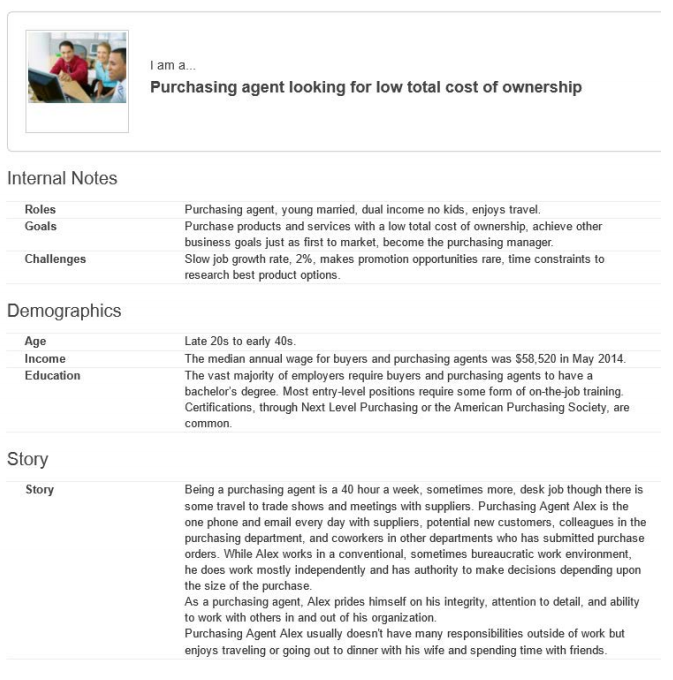A Style That Appeals to Your Buyer Personas.
Buyer personas should inform your style guide. A buyer persona is an imaginary person who best describes your ideal target: their sex, age, occupation, marital status, etc. In addition to demographic information, the most effective buyer personas include a psychographic profile including what their typical day at work and at home look like. Here’s an example buyer persona for a purchasing agent.

Big picture, depending upon your industry and buyer persona you’ll start with a style manual like APA (American Psychological Association) or another manual. From there, you’ll make other grammar decisions in addition to a company-wide style, tone, and so on.
Your buyer persona may prefer certain jargon, slang, and so on. Include that into to your style guide so that you consistently communicate with your persona in a way that resonates with them. Otherwise, you might sound unprofessional or out of touch with your market.
Consistent Voice Across All Channels
The most important reason to create a style guide and adhere to it is to create a consistent voice across all channels. If you have one person managing your social media and another persona blogging, they will naturally sound differently. Neither of them is right. What is the right style is the one that gets your buyer personas to take action. Once you have a handle on what that is, you need to employ it on social media, blogging, email, and offline content to build your brand.
Consistent Formatting Across All Channels
Just as it’s important to have a consistent voice, it’s important to have consistent formatting as well. You might not even notice subtle differences between different formatting, such as using only numerals to describe someone’s age, but be sure that there’ll be people in the audience who will notice. Even if your audience doesn’t notice consciously, formatting consistency is one of those little user experience elements that make a difference whether your audience seamlessly interacts with your marketing content or not.
And in house, formatting consistency has benefits as well. Consider:
- Saving characters on limited channels like Twitter
- Making life easier for content writers who don’t need to make new ad hoc decisions
- Reduces training time for new staff or contractors who are creating content
Avoiding Mistakes That Make You Look Unprofessional
We’re all human and that means we make mistakes, but it also means that we notice other peoples’ mistakes as well! Even more, we make judgments about the company after seeing the mistake. To make a long story short, avoiding spelling and other errors is good for your company’s reputation, authority, and improves your conversion rate.
A style guide helps prevent mistakes since there the universal way of formatting titles, referencing number, the simplicity of your word choice, and so on will become second nature over time. Ultimately, it limits the opportunities for errors and increases the likelihood that you will accurately produce content.
Reinforcing Your Brand
A consistent tone and voice are key to reinforcing your brand. People will tie your content to your brand, so the more unique but uniform your posts are, the easier it will be for your audience to tell you apart from the competition. Mistake-free, consistent content sends your visitors a message that your company is professional, dedicated, and good at what you do.
Are you ready to pick a style guide for your company? We’ve made you a style guide template you can download and use for free!





